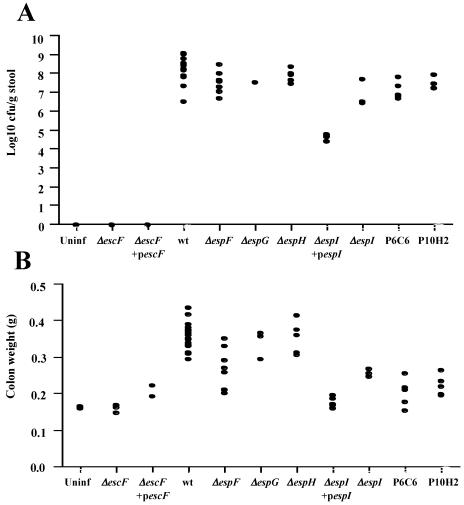FIG. 6.
Virulence of C. rodentium strains in the mouse colon. (A) Numbers of C. rodentium CFU recovered from colonic tissues of individual mice on day 13 postchallenge. Mice infected with the wild-type strain and with espF, espG, espH, and map mutants all had high pathogen burdens. In contrast, mice infected with the espI mutant strains had lower bacterial loads, although the levels were still higher than the levels in mice infected with the escF mutant and complemented strains, from which no challenge bacteria were recovered. The numbers of CFU obtained from mice infected with the espI mutant strain complemented with pICC296 were significantly higher than the numbers of CFU obtained from mice infected with the espI mutant strain (6.56 ± 042 CFU compared to 4.81 ± 0.19 CFU; P > 0.001), although the levels were not quite the same as the wild-type levels (7.98 ± 0.20 CFU). (B) The distal 8 cm of colon was removed and weighed 13 days postchallenge. Mice infected with ΔespG and ΔespH strains had colon weights that were not significantly different from the colon weights of mice infected with the wild type (P > 0.001). There was no significant difference between the colon weights of mice infected with the avirulent ΔescF strain and the colon weights of uninfected mice (P > 0.001). In contrast, the colon weights of mice infected with map mutants P6C6 and P10H2 and those of mice infected with the complemented ΔescF strain containing pICC270 and the complemented ΔespI strain containing pICC296 were significantly greater than those of uninfected mice (P > 0.05) but still significantly less than the colon weights of mice infected with the wild type (P > 0.001). Uninf, uninfected; wt, wild type.

